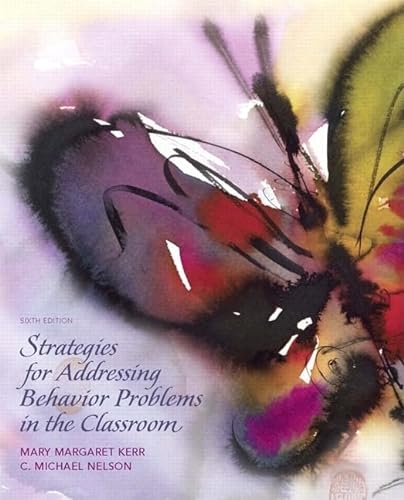
Synopsis
A comprehensive, balanced and practical text, Strategies for Addressing Behavior Problems in the Classroom, 6/e, provides a unique in-depth look at specific behaviors and the strategies employed for addressing each behavior in K-12 classrooms and schools. Readers can expect to get solid coverage of key topics, practical understanding of Applied Behavior Analysis (ABA) and a more detailed look at functional behavioral assessment (FBA) than found in other texts. Additionally, featured research-based practices from various fields outside of education (such as psychiatry and psychology), lend to a special balanced approach that helps students grasp how different methodologies contribute to behavior and classroom management in a larger context. The authors also address school-based interventions in the context of positive behavioral support, a view embraced by practitioners and supported by research, and continues to promote collaboration between other agencies and families, along with better coordination of treatment options to create effective services and intervention in education. Intended for graduate or undergraduate courses for general education and special education classroom teachers, administrators, or behavior specialists, this widely-used text is clearly written and organized in such a way that classroom teachers or school support professionals can use it in their every day practice.
"synopsis" may belong to another edition of this title.
From the Back Cover
A comprehensive, balanced and practical text, "Strategies for Addressing Behavior Problems in the Classroom, "6/e, provides a unique in-depth look at specific behaviors and the strategies employed for addressing each behavior in K-12 classrooms and schools. Readers can expect to get solid coverage of key topics, practical understanding of Applied Behavior Analysis (ABA) and a more detailed look at functional behavioral assessment (FBA) than found in other texts. Additionally, featured research-based practices from various fields outside of education (such as psychiatry and psychology), lend to a special balanced approach that helps students grasp how different methodologies contribute to behavior and classroom management in a larger context. The authors also address school-based interventions in the context of positive behavioral support, a view embraced by practitioners and supported by research, and continues to promote collaboration between other agencies and families, along with better coordination of treatment options to create effective services and intervention in education. Intended for graduate or undergraduate courses for general education and special education classroom teachers, administrators, or behavior specialists, this widely-used text is clearly written and organized in such a way that classroom teachers or school support professionals can use it in their every day practice.
"About this title" may belong to another edition of this title.
Search results for Strategies for Addressing Behavior Problems in the...
Strategies for Addressing Behavior Problems in the Classroom
Seller: Zoom Books East, Glendale Heights, IL, U.S.A.
Condition: acceptable. Book is in acceptable condition and shows signs of wear. Book may also include underlining highlighting. The book can also include "From the library of" labels. May not contain miscellaneous items toys, dvds, etc. . We offer 100% money back guarantee and 24 7 customer service. Seller Inventory # ZEV.0136045243.A
Strategies for Addressing Behavior Problems in the Classroom
Seller: Bookseller909, ANKENY, IA, U.S.A.
Condition: Acceptable. Used - Acceptable. Previous owner left stickers on cover. Book may not contain supplemental items such as CDs, access codes, etc. Seller Inventory # 25-A-0034
Strategies for Addressing Behavior Problems in the Classroom
Seller: ThriftBooks-Reno, Reno, NV, U.S.A.
Paperback. Condition: Good. No Jacket. Pages can have notes/highlighting. Spine may show signs of wear. ~ ThriftBooks: Read More, Spend Less. Seller Inventory # G0136045243I3N00
Strategies for Addressing Behavior Problems in the Classroom
Seller: ThriftBooks-Dallas, Dallas, TX, U.S.A.
Paperback. Condition: Good. No Jacket. Pages can have notes/highlighting. Spine may show signs of wear. ~ ThriftBooks: Read More, Spend Less. Seller Inventory # G0136045243I3N00
Strategies for Addressing Behavior Problems in the Classroom
Seller: ThriftBooks-Atlanta, AUSTELL, GA, U.S.A.
Paperback. Condition: Good. No Jacket. Pages can have notes/highlighting. Spine may show signs of wear. ~ ThriftBooks: Read More, Spend Less. Seller Inventory # G0136045243I3N00
Strategies for Addressing Behavior Problems in the Classroom
Seller: ThriftBooks-Dallas, Dallas, TX, U.S.A.
Paperback. Condition: Fair. No Jacket. Readable copy. Pages may have considerable notes/highlighting. ~ ThriftBooks: Read More, Spend Less. Seller Inventory # G0136045243I5N00
Strategies for Addressing Behavior Problems in the Classroom
Seller: HPB-Red, Dallas, TX, U.S.A.
Paperback. Condition: Acceptable. Connecting readers with great books since 1972. Used textbooks may not include companion materials such as access codes, etc. May have condition issues including wear and notes/highlighting. We ship orders daily and Customer Service is our top priority! Seller Inventory # S_452463702
Strategies for Addressing Behavior Problems in the Classroom
Seller: HPB-Red, Dallas, TX, U.S.A.
Paperback. Condition: Good. Connecting readers with great books since 1972! Used textbooks may not include companion materials such as access codes, etc. May have some wear or writing/highlighting. We ship orders daily and Customer Service is our top priority! Seller Inventory # S_450721981
Strategies for Addressing Behavior Problems in the Classroom
Seller: Goodwill, Brooklyn Park, MN, U.S.A.
Condition: good. All pages and cover are intact including the dust cover, if applicable . Spine may show signs of wear. Pages may include limited notes and highlighting. May include "From the library of" labels. Shrink wrap, dust covers, or boxed set case may be missing. Item may be missing bundled media. Seller Inventory # MINV.0136045243.G
Strategies for Addressing Behavior Problems in the Classroom
Seller: World of Books (was SecondSale), Montgomery, IL, U.S.A.
Condition: Good. Item in good condition and has highlighting/writing on text. Used texts may not contain supplemental items such as CDs, info-trac etc. Seller Inventory # 00095814141
